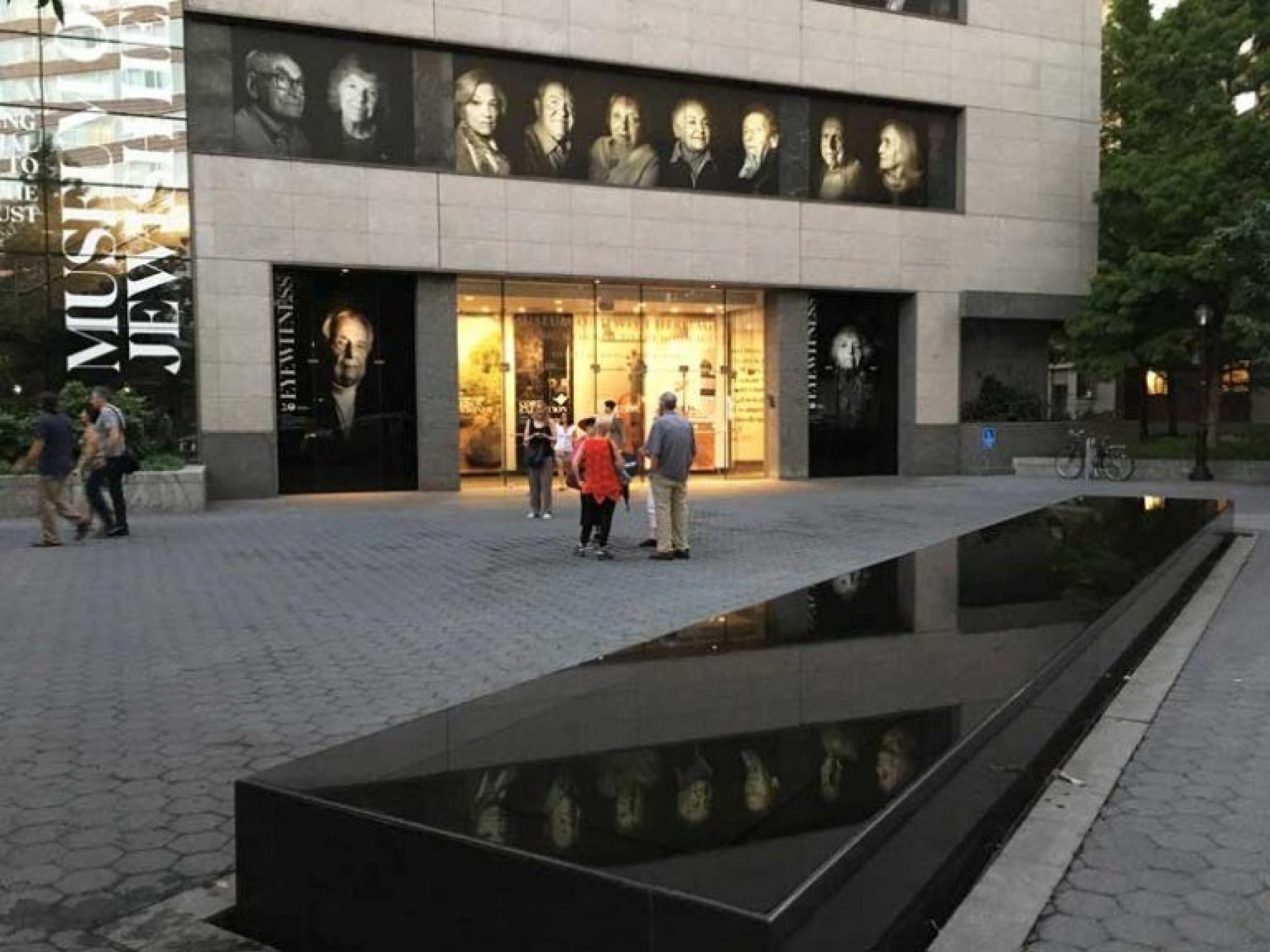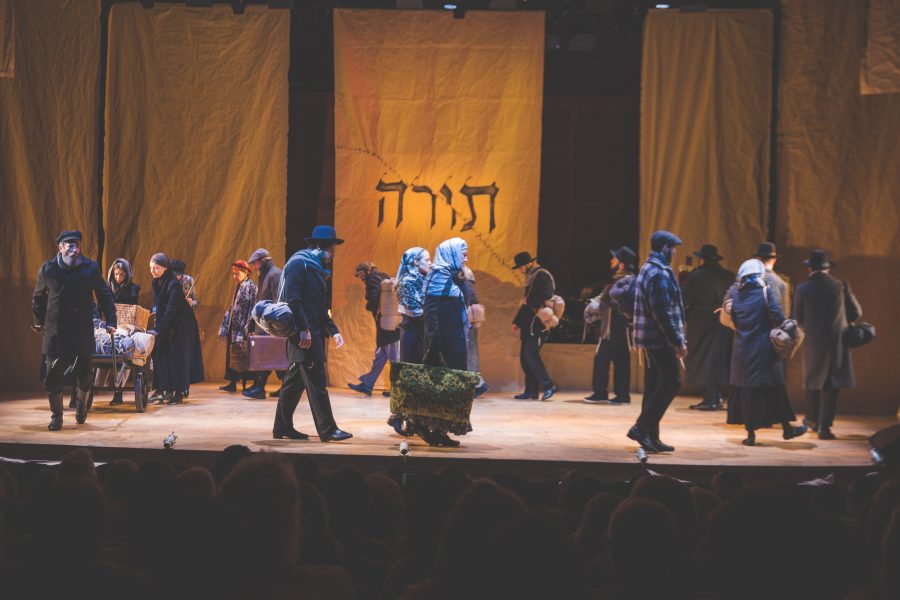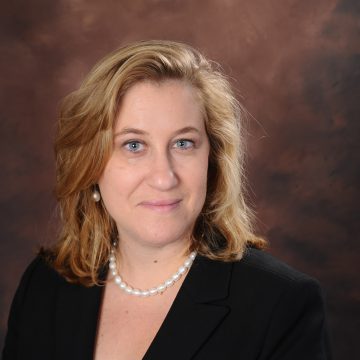
Museum of Jewish Heritage: A Living Memorial to the Holocaust, Battery Park City in Manhattan, New York City.
How Jewish Can One Fiddler Be?: Reflections on the Folksbiene’s Fidler afn dakh
Rebecca Kobrin, David Shneer
David learned about the Yiddish production of Fiddler on the Roof from his husband’s non-Jewish aunt, who lives on the Upper West Side. Auntie Kay, as we call her, has the pulse on Jewish New York like no one else, even though she’s not Jewish. He then emailed his culture-maven colleague in New York, Rebecca Kobrin, to see if she wanted to join him and his husband on Friday (a midday matinee before sunset, of course) at Fidler afn dakh, the newest production of the Folksbiene. After three hours of laughing, crying (okay, neither of us cried but plenty of tears were shed in the intimate theatre space), and applauding, we left the theatre agreeing that this was the best production of Fiddler we have seen.
We sat outside gazing out at the Statue of Liberty and Ellis Island, which is where the fictional characters in Fiddler would have found themselves after being expelled from Anatevke, felt a rare New York summer breeze, and contemplated why this was the best production of Fiddler either of us had seen. And lo and behold, we were sitting next to Daniel Kahn, who plays Perchik in the play, so he joined us in our ruminations about the show.
Daniel is one of only three actors—among the more than two dozen in the show—who already knew Yiddish. Everyone else had to learn it on the fly for this three-hour production. The question that lingered for both of us was, “What does Yiddish add?” Or better put, why did the Yiddish production turn out to be as successful as it was in rendering the fictional world created by Sholem Aleichem?
Since the majority of the audience was also not Yiddish-conversant, supertitles were projected above the stage in English and Russian. Although Hebrew could be heard in the audience among the large number of Israelis in attendance, and on stage in Tevye’s faux-Biblical verses and not-quite-right Rashi quotes, Hebrew was not the language of this tale and its theatrical world.
The language of the play very nicely reflects the world in which the characters lived, with the tsarist constable greeting Tevye with “a gutn ovnt” and Tevye replying “dobry vecher,” Yiddish and Russian respectively for “good evening,” with each speaking the language of the other. This polyglot world on stage reflected how the world might have actually operated in late nineteenth-century small-town eastern Europe. But the linguistically porous boundaries between Russian and Jew were undermined by their performances, costumes, and manners, which emphasized rigid and always imminently violent group distinctions.

Danny Burstein (Tevye) and the cast of the 2015 Fiddler on the Roof Broadway revival. Photograph: Joan Marcus/AP.
This Yiddish production reinforced the long-held mythology of American Jews: in tsarist Russia, everyone who was not Jewish was out to get the Jews. Dressed in leather, the play’s non-Jewish characters march in unison and deliver their lines in monotone authoritarianism, reinforcing the sense that Tevye and his Jewish neighbors have reason to fear them. The real friendship between the constable and Tevye [who were the same age and spoke like school chums] in Bartlett Sher’s 2015 Broadway revival of the musical is not present here. Chave’s act of conversion in order to marry seemed more natural in that production as she and Fyedke shared intellectual interests, but happened to be of different religions. Tevye’s reaction to Chave is stark and stern in this production; in Sher’s, he seemed to appreciate that conversion in order to marry could only happen if one converted to Russian Orthodoxy. (In fact, intermarriage was illegal, and it was also illegal to convert to Judaism.) And once one was Russian Orthodox, one could not partake in Jewish religious rituals.

Fiddler on the Rood in Yiddish, Finale: Ensemble. Photo:Victor Nechay / ProperPix
The non-Jews on stage, whether the Russian constable or the Ukrainian peasants, wore red clothing and knee-high leather boots and were a menacing presence throughout the production, even if they were speaking Yiddish. While this may hold true for the constable representing the “distant” tsar, for the local peasants sharing the tavern and their daily lives with the Jews of Anatevke, their menace felt like a contemporary imposition on what would have been more integrated relationships between Jews and non-Jews, in which the shabbes goy was an equally important member of the Jewish community. Moreover, the Yiddish-speaking tsarist official wore black leather boots and a cap with an eagle, (whether it was a double headed eagle was hard to make out from our seats), and this felt like an overdetermined gesture to the Nazi SS.
As for the Jews, we similarly felt like the black and white uniform of the Jewish characters reflected a backshadowing of contemporary Haredi communities in Brooklyn onto the early twentieth century Russian Jewish past with their tsitsis, shtreimels, and fear of the “goy.” This backshadowing was further brought home by the fact that the bumbling rabbi is dressed as a Satmar rebbe from Williamsburg in the wedding scene. Daniel Kahn’s assumption that Tevye lived in “a Hasidic village” (despite the fact that the so-called rebbe had no followers in the town), demonstrates the power of contemporary Brooklyn to rewrite the complexity of religious life in tsarist Russia.
As we moved offstage into the multigenerational New York audience, there were no supertitles in Hebrew, even though there were many Israelis in the audience. Presumably this is because they understand English. But why add Russian? For the same reason that the Forverts/Forward came out in Russian—to reach the large Russian-speaking Jewish community in New York City. Kahn said that the Folksbiene has always had Russian and English supertitles for its productions, because “Russian is the third-most important Jewish language for the Folksbiene behind Yiddish and English.” Here’s the irony, though: The Russian supertitles in the theatre were communicating to a Russian-speaking Jewish audience, while the Russian being performed on stage by the actors was meant to be the language of anti-semitic, tsarist imperial goyim committing pogroms against Jews.
Rebecca worked with the cast of Bartlett Sher’s 2015 revival, and this production’s portrayal of the “menacing Russians” departs most radically from Sher’s production. In her first-day introduction of the cast to the history of Jews in tsarist Russia, she stressed that Jews and non-Jews were part of one landscape; the Ukrainian peasants, with whom Tevye joked in bars, or the Russian constable, with whom he had maintained a long friendship, were not anomalies. In this production, however, the non-Jews are flattened as a uniformly fearful presence in the lives of Jews. For example, Tevye is afraid to dance with them in the tavern in this production, while in Sher’s production, he embraced and celebrated with them immediately. The tavern was a safe space for Jews and Russians [and Ukrainians and Poles] to interact, as it was usually owned and run by a Jew.
Undergirding the entire production is its Jewishness, not only marked by the fact of its being in Yiddish, which revealed the world that Tevye himself might have inhabited in a way that the original English-language Fiddler did not. If the language of the production weren’t enough, the space in which it took place—the Museum of Jewish Heritage: A Living Memorial to the Holocaust—marked the experience as a Jewish one, even if any particular audience member did not identify as such. This was not a production like Sher’s which linked the wandering of Anatevke’s residents to the recent plight of refugees, and in which Tevye was dressed as a Syrian refugee at the opening and closing of the play. This was a distinctly East European Jewish tale, of a long lost world.
We cannot end this reflection without noting that the Tevye of this production is thrilling: unlike previous Tevyes, whose stage personae loomed large and overwhelmed the show, Steven Skybell’s scrappy, exasperated, argumentative Tevye draws the audience into a dialogue that recreates Sholem Aleichem’s character more vividly than other Tevyes we have seen. The ways in which Tevye shares his love of his family, bewilderment with his situation, and dialogue with God, truly captures the power of conversation, which was the hallmark of the Yiddish theatre in America. The members of the audience around me yelled “mazel tov” during the wedding scene, gasped audibly when Tevye refuses to speak with Chave, and grew openly angry with him over his behavior. The small, 360-seat venue aided in Skybell’s recreation of Tevye—when he talks to God, he openly engages the audience. This links him to the long legacy of audience interaction in the Yiddish theatre. When Tevye dreams of being a wealthy man and sings “Ven ikh bin a Rotshild,” he shows that his wishes are not for abstract riches but to become another person—namely a member of a family that was considered Jewish nobility. Skybell becomes Tevye and draws the audience into his world unlike any other Tevye we have seen.
Read more from the DYTP about Fidler afn dakh here, here, and here.

